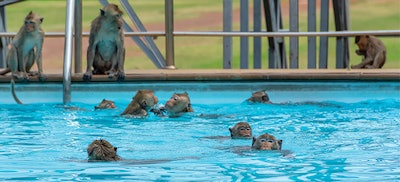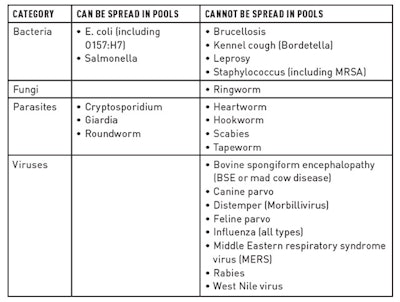
Zoonotic Disease: The Basic Facts
|
Because residential swimming pools are seldom completely enclosed, it is not uncommon for both domesticated and wild animals to enter the pool. Animals carry a large number of microbes, a few of which can cause disease. If an animal enters the pool, some of those germs may spread to humans and animals through the water. Diseases spread in this way are called zoonotic diseases. According to the U.S. Centers for Disease Control and Prevention, zoonotic diseases (also known as zoonoses) are caused by infections that spread between animals and people.
It is not surprising that wild animals are occasional pool and spa visitors — these are reliable sources of the water animals seek. Depending on the region, raccoons, opossums, frogs, toads, snakes, birds, earthworms, slugs, insects of many varieties, alligators and iguanas are just a few of the animals that are encountered. Many of these animals naturally carry germs that might, given the correct dose and portal of entry, cause disease in humans. Since the 1970's, the CDC has been recording and reporting diseases in water. A review of the CDC reports does not indicate that animals are the source of diseases in disinfected swimming pools or spas except for roundworm from raccoon feces. (To learn more, visit aqmag.co/raccoonpool)
In moist climates, frogs, toads and earthworms are frequently encountered. In many areas, frog and toad egg clusters and their tadpoles are common in poorly chlorinated early spring pools. There are not records of these animals causing diseases in pools.
Ducks and geese may use the pool for temporary refuge, especially during spring and fall migrations. Nearly all birds carry considerable amounts of Salmonella. Geese produce large amounts of droppings both in the water and on surrounding surfaces. Salmonella is killed by 1 ppm of free chlorine in 1 minute.
RELATED: Tech Notes: West Nile Virus
Mice and small rodents are occasionally found in skimmer baskets. Rodents carry multiple varieties of Salmonella. In the semiarid areas of the southwest U.S., a number of rodents including rock squirrels, wood rats, ground squirrels, prairie dogs, chipmunks, mice, voles and rabbits carry the bacterium Yersinia pestis (plague or Black bites from infected fleas. In Louisiana and eastern Texas, armadillos are occasionally observed visiting swimming pools. Some populations of armadillos carry Mycobacterium leprae (leprosy). Notwithstanding these potential exposures, there are no references in scientific literature of animals causing disease outbreaks in pools or spas, with the exception of ringworm from raccoon feces.
 Animal diseases and parasites that can and cannot be spread in pool and spa water. (Zoonotic disease reference)
Animal diseases and parasites that can and cannot be spread in pool and spa water. (Zoonotic disease reference)
Many mammals including cats, dogs, cattle, deer and beavers are known carriers of Giardia. Giardia is the most common human parasite both in the U.S. and the world. Between 2 and 4% of the U.S. human population is infected by Giardia at any one time. Between 2000 and 2014, there was one outbreak of Giardia in pools that infected 21 people. The single pool involved was not properly chlorinated. This one outbreak was 0.067% of the total Giardia infections reported in 2011-2012. There is no evidence that Giardia is transmitted in swimming pools with >1 ppm of free chlorine.
Untreated and abandoned pools are major sources of mosquitoes. Mosquitoes carry a number of viruses including West Nile and Eastern Equine Encephalitis. By technical definition, these diseases are spread by bites so they are classified as "vector-borne," not as "zoonotic" diseases. Regardless of the technical classification, mosquitoes from untreated and abandoned pools present the greatest human health threat of all the animal carried diseases.
In certain regions of the U.S., the most problematic wild animals visiting pools are reptiles. Reptiles, like birds, carry numerous varieties of Salmonella. Salmonella causes gastroenteritis in humans. When Hurricane Andrew stuck south Florida in 1992, iguanas were released into the wild and have become a major issue. In some regions, iguanas have become a pest for swimming pool owners. As noted with goose droppings above, after disposal of fecal material and proper this time that the Salmonella shed by iguanas presents a human health hazard. Refer to references below for information on possible solutions for controlling iguanas. The greatest hazard from reptiles in pools is from alligators; however, this health threat is not from zoonotic disease.
TREATMENT
Once the animal is safely removed, all fecal matter should be removed and disposed of using proper personal protection equipment such as gloves and masks. The simplest method is usually netting or scooping the material and flushing it down the toilet. It is necessary to remove the feces or it will be the source of considerable chlorine demand. After the feces is removed, test the water for free chlorine and pH. Chlorinate to >4 ppm and adjust the pH to 7.2 to 7.8. Make certain the filter and pump are operating normally so the entire pool is adequately treated. After the treatment is complete, chemically clean the filter or change the filter medium. With the exception of cryptosporidium, all the germs listed above are killed by >1.0 ppm of free chlorine for a few minutes. Make sure to clean and sanitize whatever equipment used to remove or dispose of an animal and/or its feces with a dilute solution of chlorine before they are used again.
RELATED: Where The Wild Things Are
If the water is cloudy, it is likely that superchlorination, a filter aid or water replacement will be required. It is often quicker and less expensive to drain and refill heavily fouled pools. This is especially true if the intruding animal is large, i.e., cattle. Power washing the pool after draining should be considered. Because cattle are known carriers of E. coli, giardia and cryptosporidium care should be used to avoid ingestion of splattered water during the cleaning process.
Decomposed animals, such as those discovered at spring opening, can be major sources of both odiferous compounds as well as substantial chlorine demand. At a minimum, multiple superchlorination treatments are suggested. Local pest control companies are often able to assist homeowners with disposal.
PRECAUTIONS
• If wild animals are observed in the pool, approach them with caution or call the local animal control department for assistance.
• Wear waterproof gloves (nitrile or butyl) while removing fecal material.
• Nets and gloves used to remove fecal material should be disinfected before use. After washing and rinsing contaminated items, soak them in a solution of 1.5 cup of household bleach in 5 gallons of tap water for 10 minutes. Rinse with tap water and air dry before storing them.
• Dead animals should be disposed of per local ordinance. Contact the local department of animal control or trash disposal company for specific directions.







































